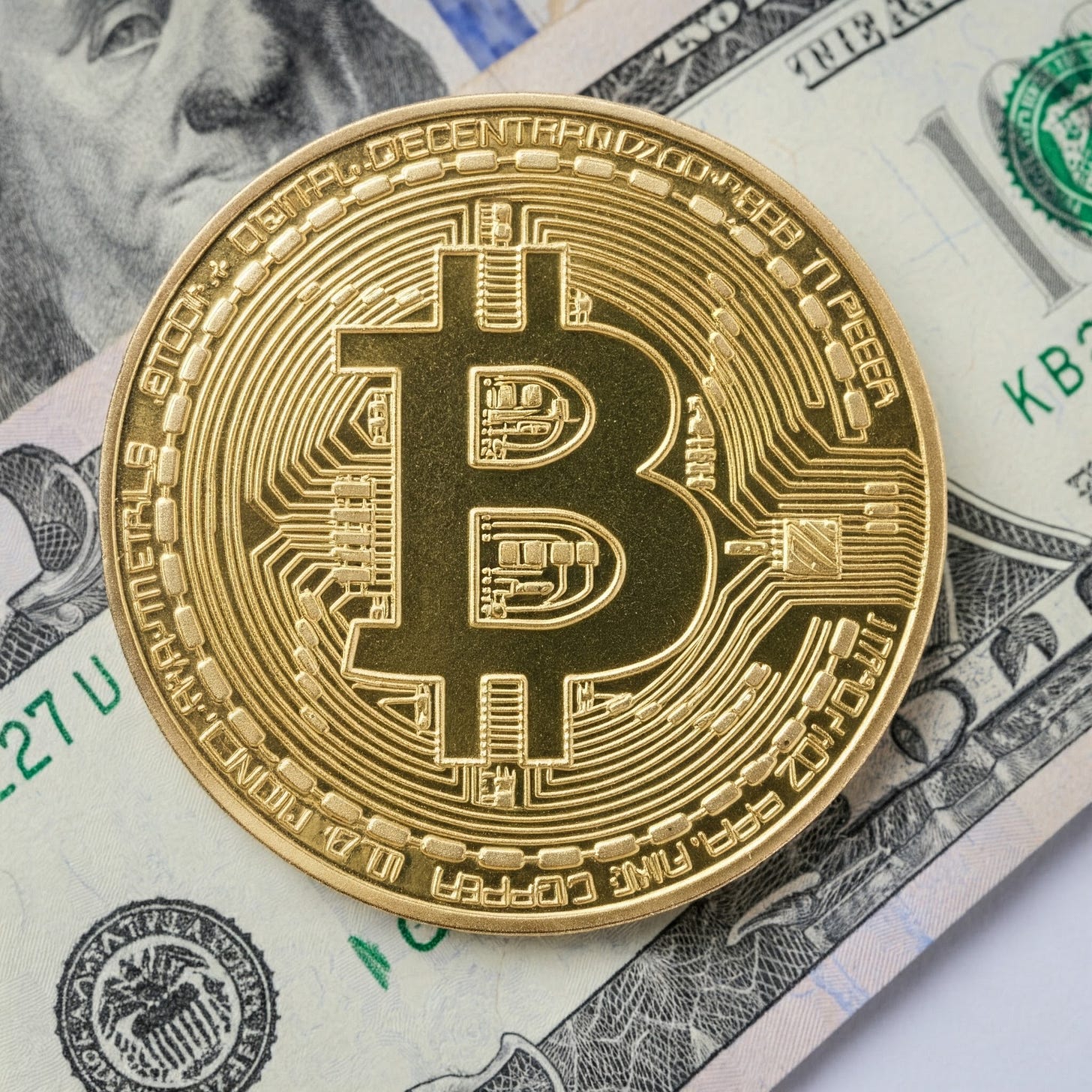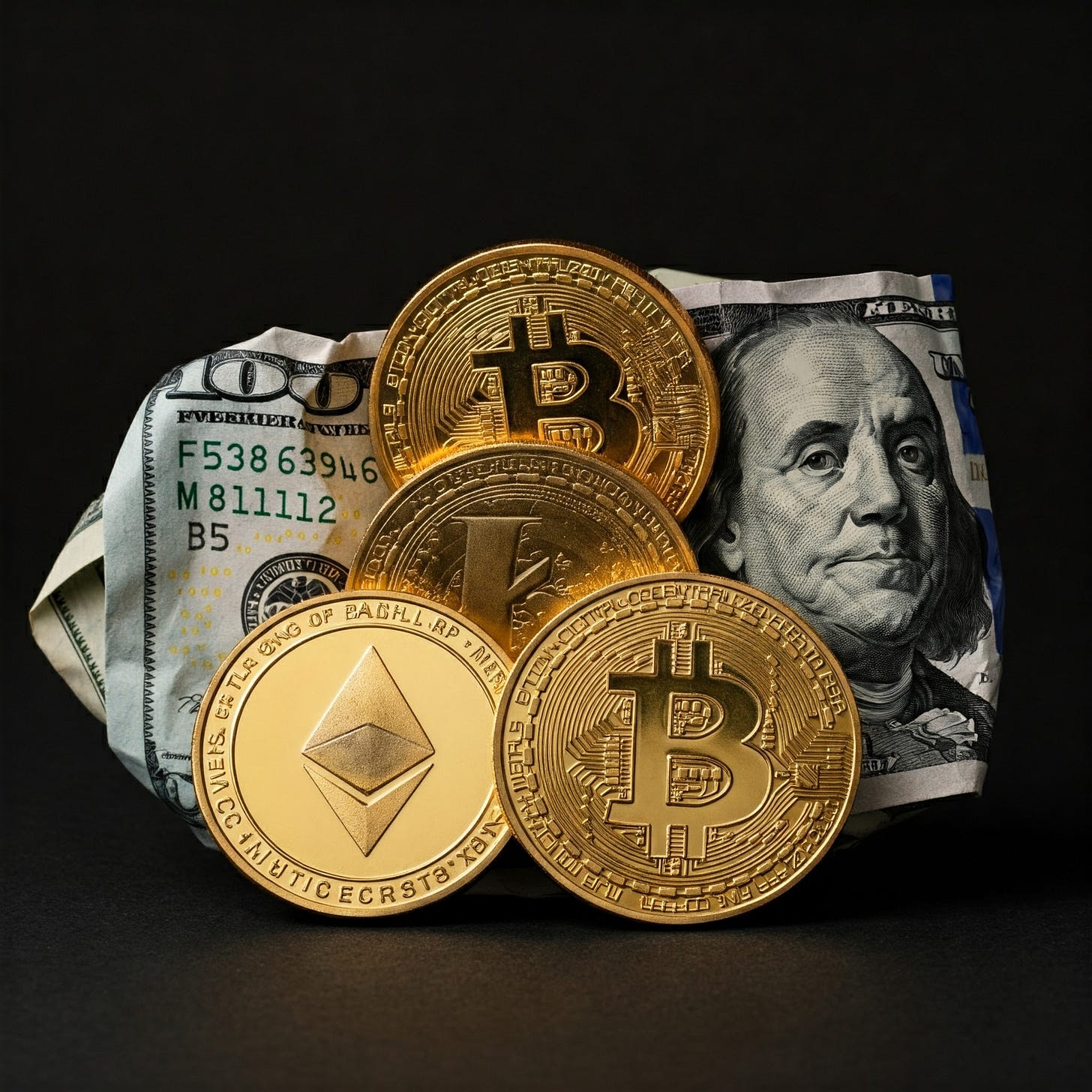Crypto Won't Kill the Dollar: Debunking the Myth that it Will & Why U.S. Adoption is Smart
At this point the benefits of embracing BTC & crypto massively outweigh the drawbacks...
Over the past few years, as the cryptocurrency market has grown into a multi-trillion-dollar ecosystem, a persistent fear has emerged: that widespread adoption of digital assets will undermine the U.S. dollar, hastening its demise as the world’s reserve currency.
Critics point to Bitcoin’s rising popularity and claim that decentralized currencies will inevitably erode trust in fiat.
However, upon close examination, this argument falters—especially now that the United States appears increasingly likely to embrace crypto rather than combat it.
Debunking “Crypto-Kills-The U.S. Dollar” Narrative
In fact, a U.S. embrace of crypto would likely help reinforce the dollar’s dominance on the global stage.
1. USD-Backed Stablecoins Drive Dollar Demand, Not Dollar Erosion
Claim: “Cryptocurrencies will make people abandon the dollar.”
Reality Check: The most widely used digital currencies for day-to-day transactions in decentralized finance (DeFi) are USD-pegged stablecoins. Tether (USDT), USD Coin (USDC), and others collectively hold hundreds of billions of dollars in reserves, much of which is in U.S. Treasuries or other dollar-denominated assets. When these stablecoins grow in circulation, they increase global demand for the U.S. dollar, because each token must be backed by dollars or dollar-equivalents to maintain its peg.
Liquidity Flood: As stablecoins proliferate globally, foreigners who might not have easy access to U.S. bank accounts or the Federal Reserve system can now hold a “digital dollar” that is transferrable worldwide. This effectively expands the “Eurodollar” system into the blockchain realm, further embedding the dollar in cross-border trade, remittances, and DeFi.
Reduced Friction: Traders and institutions can move U.S. dollar value at the speed of the internet without going through traditional banks—making the greenback even more indispensable for global commerce.
Think about it like this: Are more people going to use global digital currencies in the future? If they are trading, doing DeFi, or wanting to store money in a stronger currency - they’re going to embrace USD-backed stablecoins (e.g. USDC, USDT, etc.)… the U.S. can front-run all other countries here.
Result: Far from undermining the dollar, stablecoins turbocharge its international reach, deepening the world’s dependence on U.S. dollars for commerce and finance.
2. Bitcoin as a Complementary Asset, Not a Dollar Replacement
Claim: “Bitcoin’s rise will displace the dollar entirely.”
Reality Check: Bitcoin’s narrative is more akin to “digital gold” than a day-to-day currency that supplants fiat. Yes, Bitcoin is a global, decentralized store of value. However, it doesn’t function like a national currency or a typical medium of exchange—especially not when people crave stability for everyday purchases.
Volatility vs. Stability: Even as Bitcoin matures, price swings remain significant. This is why many DeFi applications rely on dollar-pegged stablecoins rather than Bitcoin for day-to-day transactions.
Reserved for Reserves?: If the U.S. decides to hold Bitcoin as part of its strategic reserve, this doesn’t erode the dollar; it merely adds a new hedge asset. Similar to how gold holdings don’t replace the dollar but rather backstop economic confidence, a national Bitcoin reserve could actually buttress the U.S. financial position if Bitcoin’s long-term trajectory remains positive.
Result: Bitcoin may be a useful store of value, but it’s no existential threat to the dollar’s role as a unit of account and medium of exchange. Instead, it can serve as a complementary asset that even supports the U.S. fiscal stance.
3. Regulatory Clarity Supercharges U.S. Influence
Claim: “Regulating crypto legitimizes it and hastens the end of dollar supremacy.”
Reality Check: A laissez-faire or hostile stance would push innovation offshore. By crafting clear, supportive regulation, the U.S. can shape the global rules for crypto, ensuring that dollar-denominated stablecoins and U.S.-based exchanges remain at the forefront.
Defining Global Norms: With pro-crypto leadership, the United States can become the central hub for blockchain R&D, exchange liquidity, and stablecoin issuance. In turn, global financial innovation would orbit around U.S. regulations and U.S. currency dominance.
Securing the Stablecoin Pipeline: If stablecoin issuers are overseen by U.S. regulators and must hold dollar-denominated reserves in U.S. institutions, global stablecoin usage further ties back to the American financial system.
Result: Rather than displacing the dollar, a well-regulated crypto environment cements the U.S. as a gateway for global capital flows, reinforcing the dollar’s hegemonic status.
4. The Digital Dollar: Evolution, Not Extinction
Claim: “Crypto is a zero-sum game; it competes with fiat, so the dollar loses.”
Reality Check: Crypto is simply the next evolutionary step in the digitization of financial services. Many people forget that the dollar has thrived through multiple technological shifts—from physical gold to paper money to electronic bank transfers.
Dollar 2.0 via Stablecoins: If stablecoins become the preferred way to transact digitally, the “currency” part remains the U.S. dollar. This is effectively a new version of the dollar—more accessible, more global, and more liquid.
CBDCs vs. Private Stablecoins: Even if the Federal Reserve eventually creates a central bank digital currency (CBDC), it doesn’t undermine privately issued stablecoins but can coexist with them. Both would be denominated in dollars, not supplanting the greenback but expanding its methods of distribution.
Result: The essence of the dollar—its role as the global reserve currency—remains intact. Crypto technologies simply provide modern pipelines for the same currency the world already trusts.
5. Positive Spillover Effects for the U.S. Economy
Claim: “Crypto adoption only benefits a niche group; it doesn’t help the broader U.S. economy.”
Reality Check: A robust U.S. crypto sector has major spillover benefits that inherently fortify the dollar’s status:
Innovation Magnet: Pro-crypto policies attract top-tier developers, entrepreneurs, and investors. This keeps the U.S. at the cutting edge of financial and technological breakthroughs, bolstering GDP and job growth.
Capital Inflows: If the U.S. is viewed as the global crypto hub, foreign investment flows into American startups, exchanges, and digital asset custodians—transactions that ultimately occur in dollars and strengthen U.S. capital markets.
Tax Revenue: As crypto transactions, capital gains, and business activities flourish under a U.S. regulatory umbrella, government coffers receive more tax revenue—funds that can be deployed for national priorities and debt management.
Result: Rather than erode the economy or the dollar, a thriving crypto sector in the U.S. broadens America’s fiscal and technological strength.
6. Myth Busting: Crypto and the “End of Dollar Hegemony”
Myth: Crypto’s ascendance spells the end of the greenback.
Reality: Crypto’s biggest success stories—stablecoins— are pegged to the dollar; the growth in stablecoins is a direct extension of dollar influence. And while Bitcoin’s global acceptance is rising, its function is not to replace the dollar in daily commerce but rather to serve as a universal store of value.
When a currency is so entwined in the new technology’s plumbing (via stablecoins) and the new technology’s most notable store-of-value asset (Bitcoin) doesn’t directly compete with that currency’s function, the net effect is not replacement but expansion of dollar-led markets.
Related: How Stablecoins Strengthen the U.S. Dollar as Global Reserve Currency
Final Take: Embracing Crypto Strengthens the U.S. Dollar & Economy
To frame crypto adoption as an assault on dollar supremacy is to misunderstand the evolving dynamics of financial technology. For every measure of risk, there’s an offsetting advantage—especially when pro-crypto policies are carefully designed with the dollar’s central role in mind.
USD Stablecoins directly strengthen the dollar’s global footprint.
Bitcoin can serve as a strategic hedge, not a currency competitor.
Regulatory clarity cements the U.S. as the world’s fintech hub.
Dollar digitization is a natural evolution, not a displacement.
By embracing crypto, the U.S. doesn’t shoot itself in the economic foot. On the contrary, it seizes the opportunity to modernize the dollar, extend its international reach, and maintain a competitive edge in finance and technology.
In short, the rise of crypto can be a massive tailwind for the greenback—if Washington harnesses it properly.




